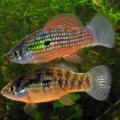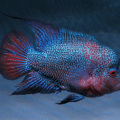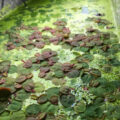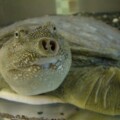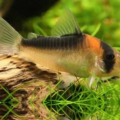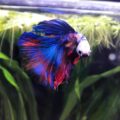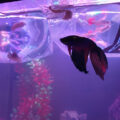This guide helps you distinguish the vibrant True Flying Fox fish from other similar-looking algae-eating species. It also includes special care tips for keeping this species in a home aquarium from tank setup to breeding.
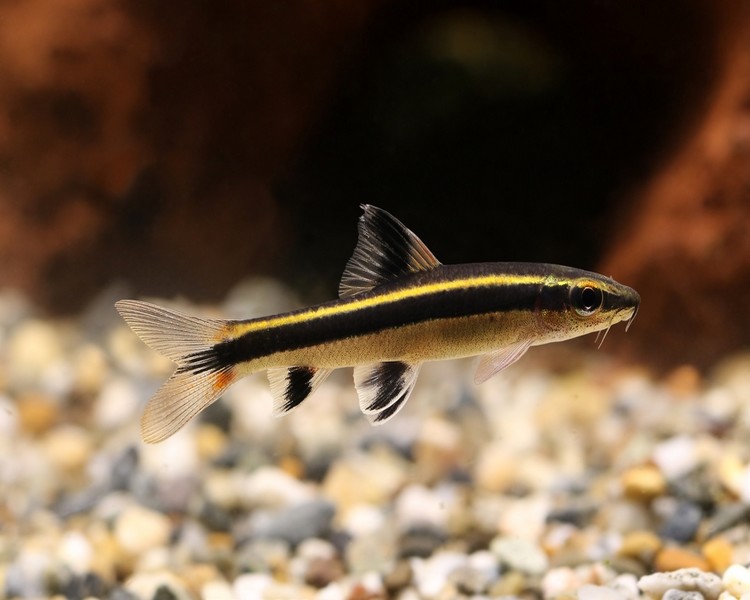
Introduction
Today’s True Flying Fox introduction is necessary to unravel the often misunderstood and underappreciated aquarium fish species, Epalzeorhynchos kalopterus, a.k.a True Flying Fox, Flying Fox, and White Flying Fox.
Because of their unique features, including a streamlined body with subtle coloration and an algae-eating habit, aquarists often mistake this species for others, such as the Siamese Algae-Eater and False Flying Fox.
This Epalzeorhynchos kalopterus overview highlights its distinguishing characteristics to help with identification. There’s also a brief comparison of True Flying Fox vs Siamese Algae Eater and False Flying Fox to ensure you choose the right species for your tank, up next.
Author’s Note: Check out our post on the 14 Small & Big Freshwater Pet Sharks for more Freshwater Home Aquarium compatible shark lookalikes.
How to Recognize a True Flying Fox
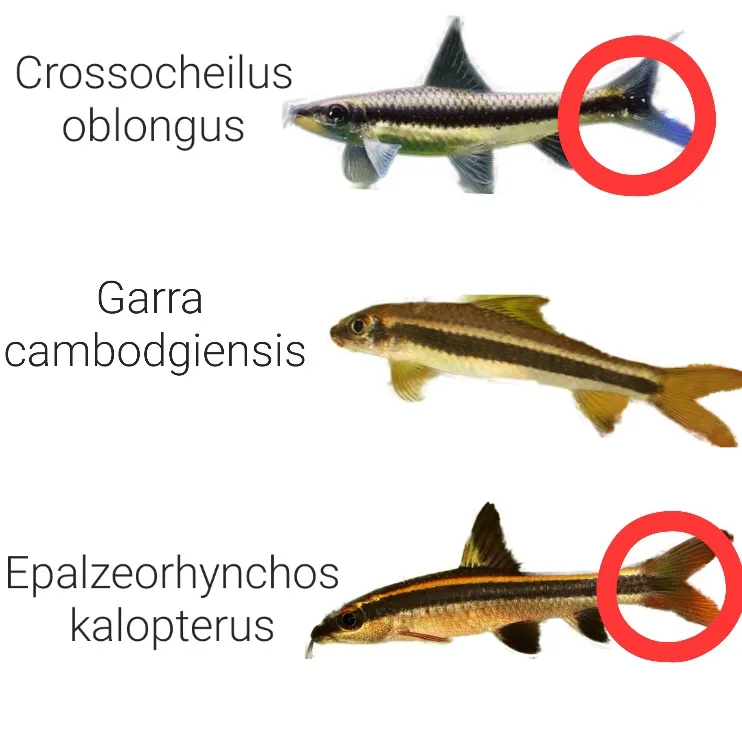
Earlier, I mentioned that beginners often mistake True Flying Fox for other species, so here’s a foolproof method for identifying Epalzeorhynchos kalopterus.
We’ll first detail their obvious appearance and then highlight the subtle characteristics that distinguish them from False Flying Foxes and Siamese Algae-eaters.
Size
This species has a slender body that grows up to 6 inches long in maturity.
Color Pattern
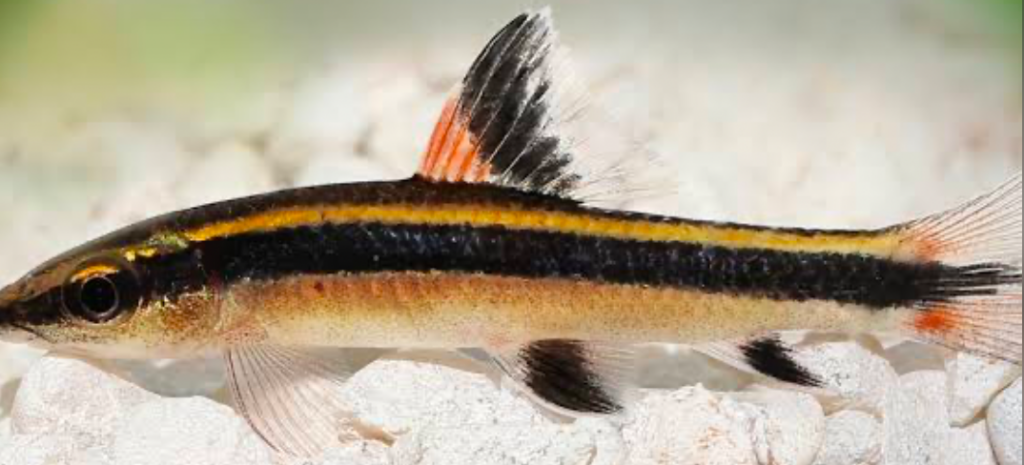
Look out for the following True Flying Fox fish markings as clear identifying features:
- A horizontal black stripe forming a lateral band
- A gold line above the black stripe
- Black and white tips on dorsal and anal fins
Only the True Flying Fox has the striking gold stripe on its body. And its horizontal black stripe extends onto its tail fin.
Here’s a convenient breakdown,
- True Flying Fox (Epalzeorhynchus kalopterus):These fish have a black stripe that extends from the head to the tail, and they do have two barbels around their mouths.
- False Flying Fox (Garra cambodgiensis):These fish have a black stripe that stops before the tail fin, and they have a single barbel.
- Siamese Algae Eater (Crossocheilus oblongus):These fish have a black stripe that extends from the head to the tail, and they have one pair of barbels.
- Chinese Algae Eater (Gyrinocheilus aymonieri):These fish have a zig-zag black stripe that runs the length of their body, and they have two pairs of barbels.
Recommended Tank Setup for a Healthy Flying Fox
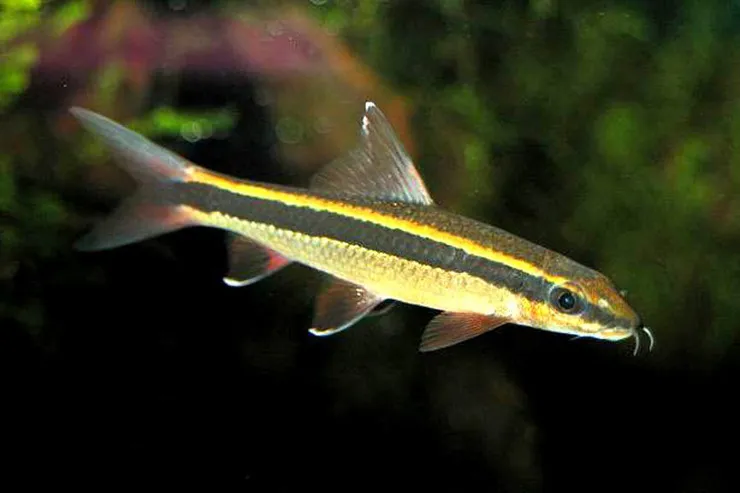
Use this Flying Fox tank setup guide to create a livable ecosystem for your pet. It includes tips on tank size, layout, water flow, quality, decor, and substrates.
Tank Size
Get a tank that’s at least 30 gallons large for adult True Flying Fox Fish. Depending on your preference, it may be long, tall, or round, but make sure you design an aquarium layout for algae eaters.
That means you can make a planted tank with decor that encourages algae growth without stressing about cleaning.
Tank Features
A planted tank design for stream fish, such as the True Flying Fox, requires careful plant selection.
The aquarium will need dense vegetation, shaded spots, hiding areas, and an open swimming space. Mix tall plants with small, floating plants to create density. Some good options include Frogbits, Java Ferns, Amazon Swords, and Moss.
Arrange the plants on the tank’s walls and edges to create an open swimming space for your True Flying Fox.
Finally, add natural hiding places like driftwood to release tannins for softening the water and smooth rocks that are safe and gentle on your pet’s body. It’s the perfect blend of aesthetics and functionality.
Lighting & Flow
True Flying Fox fish thrive in moderate lighting conditions, with moderate water current and good oxygenation. For an ideal environment, set the following parameters.
| Temperature | 68 – 80°F |
| pH | 6.0 – 8.0 |
| Hardness | 5 – 20dGH |
Add a powerful external filter to keep the water pristine. External filters ensure enough space inside the tank for movement and produce good currents while handling waste.
Feeding the True Flying Fox: Natural Cleaner with a Varied Diet
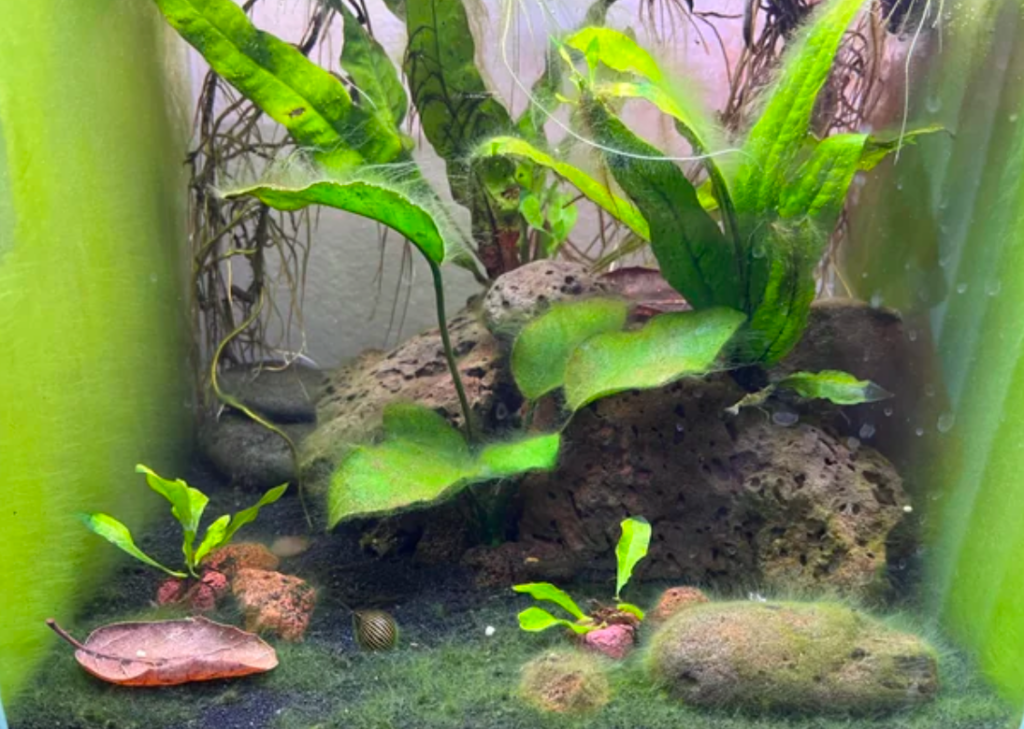
Although this species is a natural algae eater, you must make a Flying Fox fish diet plan for their omnivorous taste. The varied diet will help them grow physically, improve their appearance, and boost their immunity.
Feeding Frequency
Your omnivorous algae-eater’s feeding routine should regulate the amount of food they consume. They’re natural grazers and foragers, but they shouldn’t eat more than 1 – 2 times daily to reduce the risk of overfeeding.
Remove uneaten food from the water 24 hours after feeding to keep it clean and avoid contamination.
Diet Suggestions
Feed your pet staples like shrimp pellets and protein-rich treats like bloodworms, but don’t forget vegetables.
True Flying Fox eats algae wafers, spirulina, zucchini, and blanched veggies to help their gut health and add more flavor to their meals. These vegetables and leafy greens are great natural tank cleaner nutrition supplements.
Author’s Note: For more on feeding your aquatic pets check out The Ultimate Guide to Fish Food: Pros and Cons & Best Choices!
Suitable Tank Mates for a Peaceful Community
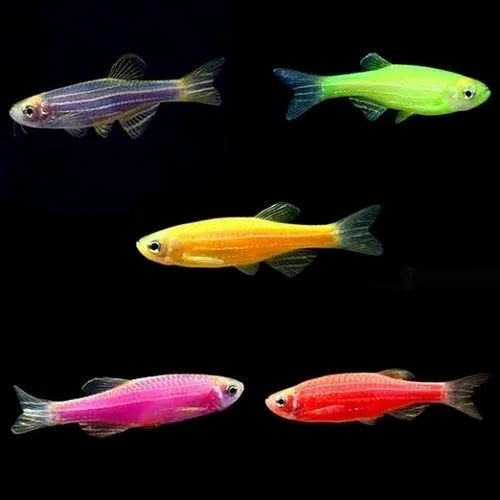
True Flying Fox’s compatibility with other species determines the success of a community tank. Due to its small size and peaceful nature, this fish can cohabit with several other peaceful and fast tank mates to avoid potential chasing.
Compatible Tankmate Species
Some compatible peaceful community fish for algae eaters include Tetras, Danios, Rasboras, and Barbs.
Tankmate Species to Avoid
Ensure you choose only suitable tank mates for mid-level swimmers to reduce the risk of aggression, territoriality, and bullying. Avoid any species that may compete for algae or space, such as other Epalzeorhynchos species and large, aggressive cichlids.
Breeding and Reproduction Notes
Epalzeorhynchos kalopterus reproduction in home aquariums is extremely rare and largely undocumented because of its unique breeding nature and needs. However, expert aquarists breed them commercially using hormone induction in controlled environments.
Captive Breeding
If you’re into freshwater fish captive breeding, prepare to face challenges and ensure you have access to vast resources like commercial farms, special hormones, and more.
Spawning Info
Because of these Flying Fox fish breeding challenges, professionals typically transfer juveniles from the wild into their home aquariums. There’s also speculation that this species’ breeding method is egg-scattering in the wild.
Health Concerns and General Care Tips
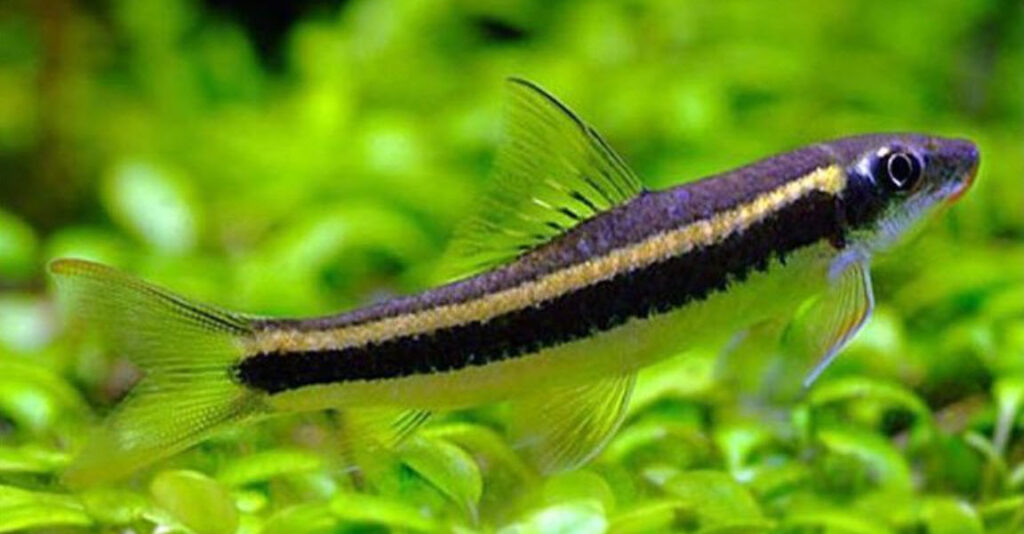
You’re almost at the finish line, so don’t give up now. Once you provide your pets with a suitable ecosystem and access to nourishing food, you’ll need this Flying Fox fish health guide to maintain their well-being.
They face health risks such as ich, fin rot, and stress from poor tank management and lifestyle conditions. So here are some preventative care tips and illness symptoms to help you stay on top of things.
Preventative Care
The following are Epalzeorhynchos kalopterus disease prevention strategies:
- Maintain a clean tank by removing uneaten food with a powerful water filter.
- Maintain consistent parameters and avoid abrupt environmental shifts that lead to stress.
- Make regular water changes.
- Pair them with only stable companions.
- Monitor your True Flying Fox fish for changes in color or activity.
Watch For
Look for stress signs in freshwater fish, like continuous scratching behavior, dull coloration, and fin clamping.
Immediately separate the sick fish and improve the living conditions with first aid before visiting a vet for proper diagnosis and treatment.
Lifespan and Long-Term Considerations
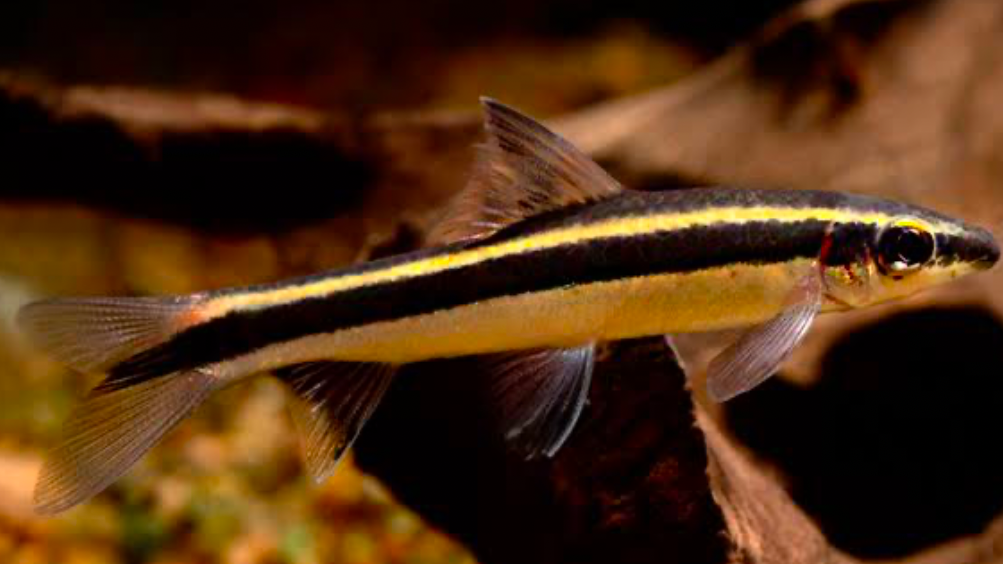
Before you get carried away by its beauty and ease of care, let me warn you that the True Flying Fox is a long-term care stream fish. With proper maintenance, it’ll live up to 8–10 years.
So, you must prepare for the Flying Fox fish’s lifespan by planning tank upgrades as they grow and maintaining a peaceful tank environment in the long term.
Growth Info
As a small fish that reaches up to 6 inches in length by adulthood, you’ll need a small to medium-sized 30-gallon tank for housing. You can, however, increase the aquariums size depending on the number of species that make up your community.
Long-Term Tip
Here are more long-term care tips for aquarium algae control species such as the True Flying Fox fish.
- Provide medium to low current flow,
- Ensure constant algae-rich surfaces for regular feeding, but don’t overfeed them. Scroll up for the specific dietary guide.
- Periodically check on your pets for behavioral and physical changes. This will help you notice signs of illness more quickly.
For the best results, follow the instructions in this guide from top to bottom. It has everything you need!
Conclusion: A Utility Fish with Unique Appeal
Reading this Epalzeorhynchos kalopterus profile shows that you’re a caring aquarist worthy of owning this species. You can now successfully keep this gold-trimmed slender fish in your home aquarium without stress.
Let’s review the True Flying Fox aquarium care summary in this guide one last time:
- They’re efficient tank cleaners with a healthy algae-eating diet
- They’re peaceful tank companions
- They require a medium-sized space
Do you agree that these features make the True Flying Fox a practical yet elegant algae control fish for community tanks? Share your thoughts in the comment box below.

